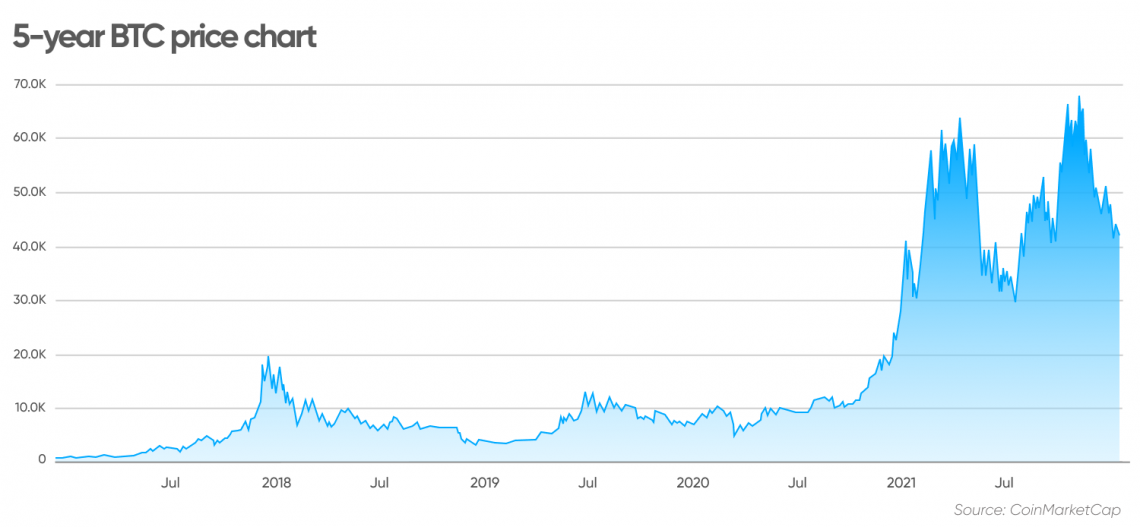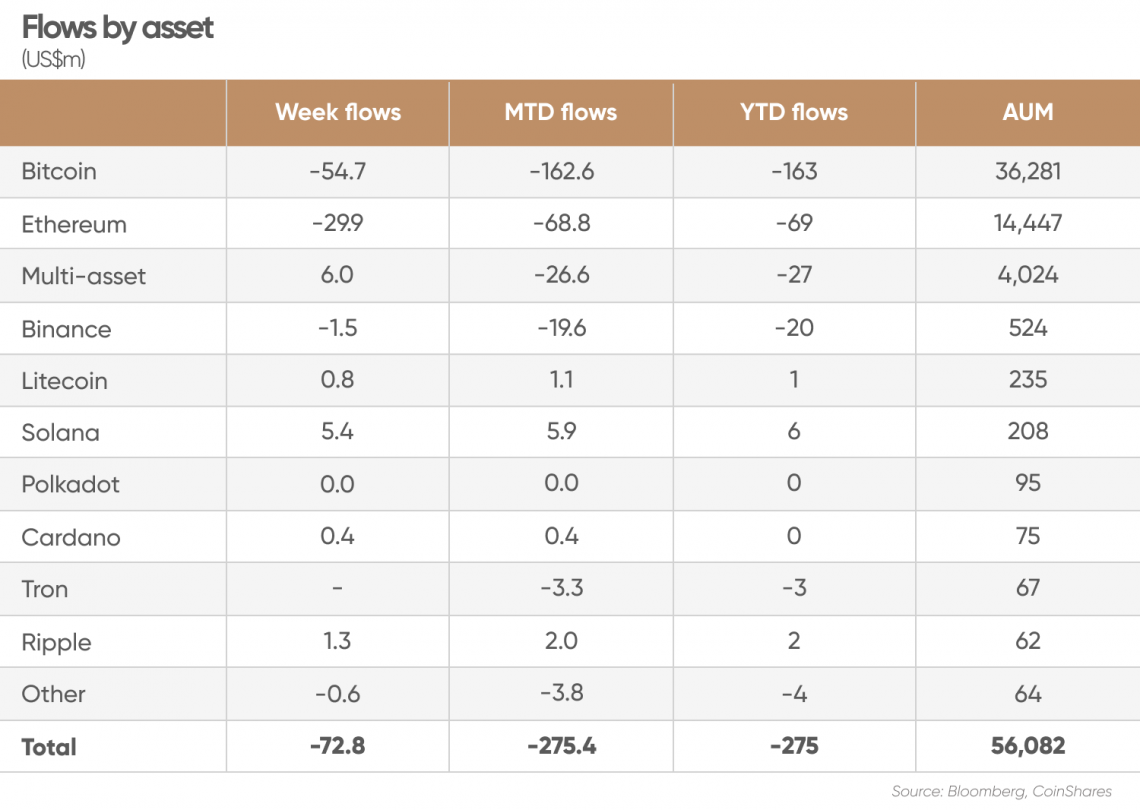Bitcoin analysis: Where is BTC heading in 2022?

Bitcoin (BTC) has lost 8.5% since the start of the year. Negative sentiment has dominated the market since the coin hit an all-time high approaching $70,000 in November.

Will bitcoin go up or down in 2022? What are the current drivers for the market?
In this bitcoin update, we look at the latest predictions for the direction of the largest cryptocurrency.
Bitcoin investment inflows resume
When the BTC value reached a high of $68,789.63 on 10 November, market observers reiterated their calls for the price to continue climbing to reach the $100,000 level. But the market quickly entered selloff mode for the rest of 2021, and fell to $39,796.57 on 10 January.
Since then, the bitcoin trend has been relatively stable around $42,000-43,000.

The market has remained under pressure on a combination of profit taking in a highly leveraged market, a selloff in speculative and technology stocks that are correlated with cryptocurrencies, and expectations of accelerating interest rate hikes, according to Mads Eberhardt, cryptocurrency analyst at Dutch bank Saxo.
“Digital asset investment products saw outflows totalling US$73m, the 5th week of outflows with this run now totalling US$532m,” according to digital asset manager CoinShares’ report for the week ending 14 January.
Year-to-date outflows from bitcoin funds have totalled $163m, of which $54.8m left funds in the past week. There was a total of $36.28bn in bitcoin-related assets under management, the data shows.

Investment interest in bitcoin continued to grow during 2021, with inflows rising by 16% from $5.4bn to $6.3bn.
“Digital asset investment products saw inflows totalling US$9.3bn in 2021, a 36% increase from 2020. While the increase from 2019 to 2020 was significantly higher at 806%, we believe this represents a maturing industry, with total assets under management (AuM) ending the year at US$62.5bn in 2021 versus just US$2.8bn at the end of 2019,” according to CoinShares’ annual review.
Last year saw El Salvador became the first country to adopt bitcoin as legal tender. Netki, a digital identity verification provider, said on 18 January that it has recently completed Know Your Customer (KYC)/anti-money laundering (AML) onboarding for the country’s official Chivo wallet.
“Through the use of Netki’s flagship KYC/AML product, OnboardID, the country’s government was able to onboard over four million users within 45 days onto its Chivo Wallet, while safeguarding the wallet from attempted airdrop fraud. Netki estimates that OnboardID facilitated the first-time compliant onboarding of 70 percent of the country’s previously unbanked population onto the Chivo Wallet,” the company said.
Investment firm ARK Invest has developed a framework for valuing bitcoin based on network health, buyer and seller behaviour and asset valuation.
“Because Bitcoin – the blockchain – and bitcoin – the cryptocurrency – do not resemble traditional asset classes, many investors seem to be grappling with ways to analyze them fundamentally. In our view, Bitcoin’s value is a function of its economic utility, while bitcoin’s value is a function of its supply and demand. Over the short- to medium-term, we believe investors should be able to assess buyer and seller behavior on Bitcoin and use relative-value metrics to manage bitcoin positions actively,” wrote analyst Yassine Elmandjra.
The company’s chief executive officer, Cathie Wood, who has repeatedly stated a bitcoin price target of $500,000 in the next five years, referred to the utility of bitcoin in an interview with Time: “The President in El Salvador is giving $30 of bitcoin to every eligible adult. And what we’ve seen there is that, roughly, whereas only 1.2 million people have access to financial services, 3 million people now have access to new banking services and new financial services, thanks to blockchain technology.”
However, in December, the Bank of England (BoE) warned that “the very scarcity on which bitcoin is based might also be its undoing. Its scarcity may even, ultimately, render bitcoin worthless… absent some intervention by the disparate group of developers and miners that preside over the Bitcoin codebase, simple game theory tells us that a process of backward induction should, really, at some point, induce the smart money to get out. And were that to happen, investors really should be prepared to lose everything. Eventually.”
What do forecasts indicate about the direction of the bitcoin price news?
Bitcoin analysis: Will BTC rise or fall in 2022?
Analysts at Santiment noted on 18 January that “In the midst of #bitcoin's 10-week price retrace, its ratio of supply on exchanges has dropped to its lowest level since November, 2018. Traders moving $BTC to cold wallets continues, and this milestone points to less risk of continued major selloffs.”
Bitcoin technical analysis from analysts at Dutch bank Saxo last week indicated that the coin could be a buy at $40,604 with a stop loss at $39,888. “With signals for sentiment at oversold extremes, the dip could not be extended. 41517 has been pivotal. Offers ample risk/reward to buy at the market. Bullish divergence is expected to support prices. We continue to expect further losses to be limited and look to set longs for a further drive higher within the channel,” the analysts wrote.
At the time of writing, there was technical support for bitcoin down to $39,000, with resistance at $42,800.
The latest bitcoin price prediction from algorithm-based forecasting site Wallet Investor estimated that bitcoin could return to the previous high towards the end of this year and hit $70,000 in December. The site predicted the price could hit $100,258 at the end of 2023 and reach $159,005 by the end of 2025.
Jan Wüstenfeld, an analyst at Quantum Economics, suggested that the bitcoin halving cycle – the time between the reward for bitcoin mining being cut in half – could indicate price direction.
As the second halving cycle took longer than the first for the bitcoin price rise to reach a cycle high, “that would mean it would take the current halving cycle (cycle 3) 757 days to reach an all-time high. This [will] take place in June 2022.”
However, Wüstenfeld added: “It is impossible to say whether bitcoin prices will reach their next record before or after June, as this depends on a wide range of factors… Rising inflation, a Federal Reserve whose policy makers are becoming more hawkish, and a potential rate hike in March will likely be the determining factors that affect bitcoin prices in the coming months. Depending on how these play out, the realisation of this cycle’s all-time high might be pushed out even further than stated above, or in the worst-case scenario, bitcoin might already be in a bear market.”
It’s important to keep in mind that cryptocurrency markets remain extremely volatile, making it difficult to accurately predict what a coin’s price will be in a few hours, and even harder to give long-term estimates. As such, analysts can and do get their predictions wrong.
We recommend that you always do your own research, and consider the latest market trends, news, technical and fundamental analysis, and expert opinion before making any investment decision. And never invest more than you can afford to lose.
Markets in this article
Related topics
